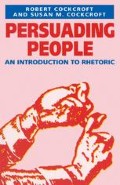Abstract
This book has been written in accordance with a very definite order of priorities. Its main purpose in studying persuasive techniques is to encourage you to develop them for yourself. Its secondary purpose is to analyse persuasive practice both written and spoken, because you need to analyse the persuasive language of others, before you can adequately synthesise your own. This will involve the development of a variety of critical skills. And in order to form judgements about the effectiveness of any kind of persuasion, we shall need to place it within its functional, structural and socio-historical context. In practice, this means looking at extracts ranging from Shakespeare to the newspaper cookery column, from John Keats’s poetry to John F. Kennedy’s speeches. Progressing through a range of examples from successive periods, we shall examine how persuasion is used for many different purposes — at one extreme to create the ultimate tragic emotion, at the other to sell us a car. In so doing, readers will have the opportunity to learn to recognise the flexibility of persuasive techniques, and to develop this skill for themselves.
Preview
Unable to display preview. Download preview PDF.
Notes
M. Billig, Arguing and Thinking: A rhetorical approach to social psychology (Cambridge: Cambridge University Press, 1987).
Aristotle, The ‘Art’ of Rhetoric, trans. J. H. Freese, Loeb Classical Library (London: Heinemann, 1959) pp. 14–15. All further quotations from The Rhetoric are from this translation.
For example, Herbert W. Simons (ed.), Rhetoric in the Human Sciences (London: Sage, 1989).
See Wayne C. Booth, The Rhetoric of Fictionn (Chicago, 1961);
Christine Brooke-Rose, A Rhetoric of the Unreal: Studies in Narrative & Structure, especially of the Fantastic (Cambridge: Cambridge University Press, 1981).
G. A. Kennedy, Classical Rhetoric and its Christian and Secular Tradition from Ancient to Modern Times (London: Croom Helm, 1980).
Brian Vickers, In Defence of Rhetoric (Oxford: Oxford University Press, 1988).
Plato, Gorgias, trans. W. Hamilton (Harmondsworth: Penguin, 1960).
See A. J. Minnis (ed.), Medieval Theory of Authorship: Scholastic Literary Attitudes in the Later Middle Ages, 2nd edn (Aldershot: Scolar Press, 1988).
William Langland, Piers the Ploughman, trans. J. F. Goodridge (Harmondsworth: Penguin, 1959).
This is a prose translation: for the effect of the verse see Tom Paulin’s version of lines from the Prologue in his Faber Book of Political Verse (London, 1986), pp. 58–9, or (for the original)
E. Salter and D. Pearsall (eds), Piers Plowman, York Medieval Texts (London: Arnold, 1967).
See T. W. Baldwin, William Shakspere’s small Latine and lesse Greeke, 2 vols (Urbana: Illinois University Press, 1956), and
Sr. Miriam Joseph, Shakespeare’s Use of the Arts of Language (New York: Columbia University Press, 1947).
See the political readings of Marlowe and Shakespeare by Simon Shepherd, Marlowe and the Politics of Elizabethan Theatre (Brighton: Harvester, 1986), and
Jonathan Dollimore, Radical Tragedy: Religion, Ideology and Power in Shakespeare and his Contemporaries (Brighton: Harvester, 1984).
For two phases of rhetorical subversion and propaganda see L. A. Schuster et al. (eds), Works of St. Thomas More, Vol. 8 (New Haven: Yale University Press, 1973), and
G. E. Duffield (ed.), The Work of William Tyndale (Philadelphia, 1965), and (for the later Marprelate controversy), The Marprelate Tracts, 1588–1589, facs. (Menston: Scolar Press, 1967), and
Thomas Nashe, An Almond for a Parrat, in Works, ed. R. B. McKerrow (Oxford: Blackwell, 1958) III 337–76.
In the Cambridge comedy The Pilgrimage to Parnassus, Act III, the Puritan Stupido has been tutoring himself with the aid of Ramus (see J.B. Leishman [ed.], The Three Parnassus Plays [London, 1949] pp. 110–6); and in John Brinsley’s Ludus Literarius, or the Grammar Schoole (ed. E. T. Campagnac [Liverpool: University Press, 1917] pp. 182–3), the Ramist Art of Meditation is recommended as the most promising way of enabling ‘Schollers . . . ‘[to] invent plenty of good matter’ (though a further clarification and exemplification is desired to make the book fully suitable for school use).
See Liddell and Scott, A Greek-English Lexicon, new edn by S. H. Jones and R. McKenzie (Oxford: Oxford University Press, 1973) s.v. logos, senses III.1, 2, 4, 5; IV; V.4; VI.
As summarised (with the elaborations of Bach and Harnish) by Martin Steinmann Jr., ‘Speech-Act Theory and Writing’, in Martin Nystrand (ed.), What Writers Know: the Language Process and Structure of Written Discourse (London/New York: Academic Press, 1981/2) p. 296.
H. P. Grice, ‘Logic and Conversation’, in P. Cole and J. L. Morgan (eds), Speech Acts (New York: Academic Press, 1975) pp. 41–58. Summarised by Marilyn Cooper in Nystrand (see above) p. 112, and in
David Crystal, The Cambridge Encyclopedia of Language (Cambridge: Cambridge University Press, 1987) p. 117.
Quoted by Christopher Butler, Systemic Linguistics: Theory and Applications (London: Batsford, 1985) p. 149.
See Malcolm Coulthard, An Introduction to Discourse Analysis, 2nd edn, Applied Linguistics and Language Study Ser. (London: Longman, 1985).
John J. Gumperz, Discourse Strategies, Studies in Interactional Sociolinguistics 1 (Cambridge: Cambridge University Press, 1982), pp. 187–203.
Quoted by M. V. Jones, ‘Bakhtin’s Metalinguistics’, in Essays in Honour of Walter Grauberg, ed. C. S. Butler et al., University of Nottingham Monographs in the Humanities, VI (Nottingham: 1989), p. 108.
See M. A. K. Halliday, Explorations in the Function of Language, Explorations in Language Study Ser. (London: Arnold, 1973) pp. 36–42.
Joseph Heller, Catch 22, Corgi edn (London, 1961), p. 54.
Author information
Authors and Affiliations
Copyright information
© 1992 Robert Cockcroft and Susan M. Cockcroft
About this chapter
Cite this chapter
Cockcroft, R., Cockcroft, S.M. (1992). Introduction: Rhetoric Defined. In: Persuading People. Palgrave, London. https://doi.org/10.1007/978-1-349-22254-4_1
Download citation
DOI: https://doi.org/10.1007/978-1-349-22254-4_1
Publisher Name: Palgrave, London
Print ISBN: 978-0-333-47163-0
Online ISBN: 978-1-349-22254-4
eBook Packages: Palgrave Social & Cultural Studies CollectionSocial Sciences (R0)

